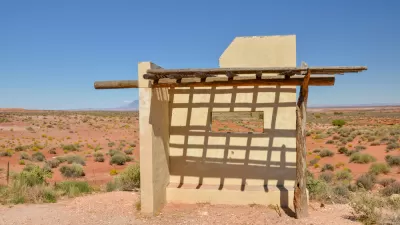Advocates for tribal communities argue that the bipartisan infrastructure bill does not direct enough money to tribal transportation needs, but USDOT and local leaders can ensure more equitable distribution of funds to projects on tribal lands.

A blog post from Tala Parker, a summer fellow at the Natural Resources Defense Council (NRDC), examines the funding available for tribal transportation projects in last year’s infrastructure law, the potential for improvements, and the shortfalls of the bill in addressing the high rates of traffic violence on tribal lands.
“While the overall budget doubled, funding for Tribal transportation only increased by about 50 percent (from $2.4 billion in the FAST Act to $3.8 billion in the infrastructure law).” Parker explains that this increase is clearly inequitable, in part because Native people die at disproportionately high rates on roadways, and because the funding is not even proportionate to the Native population.
It is still possible to close the gap between the infrastructure law’s inadequate Tribal funding allocation and an equitable spending strategy, if the federal government and states succeed in allocating an additional $9-10 billion to address needs identified by Indigenous communities.
Parker outlines the oversight and long-term capacity building necessary to successfully implement this approach. Because the federal government did not direct enough funds to tribal roads and transportation in the bill, Parker writes, it’s up to state governments, tribal leaders, and the Department of Transportation to ensure an equitable distribution of resources that will improve safety and transportation options in tribal communities.
FULL STORY: Infrastructure law short on tribal transportation spending

Alabama: Trump Terminates Settlements for Black Communities Harmed By Raw Sewage
Trump deemed the landmark civil rights agreement “illegal DEI and environmental justice policy.”

Planetizen Federal Action Tracker
A weekly monitor of how Trump’s orders and actions are impacting planners and planning in America.

The 120 Year Old Tiny Home Villages That Sheltered San Francisco’s Earthquake Refugees
More than a century ago, San Francisco mobilized to house thousands of residents displaced by the 1906 earthquake. Could their strategy offer a model for the present?

Ken Jennings Launches Transit Web Series
The Jeopardy champ wants you to ride public transit.

BLM To Rescind Public Lands Rule
The change will downgrade conservation, once again putting federal land at risk for mining and other extractive uses.

Indy Neighborhood Group Builds Temporary Multi-Use Path
Community members, aided in part by funding from the city, repurposed a vehicle lane to create a protected bike and pedestrian path for the summer season.
Urban Design for Planners 1: Software Tools
This six-course series explores essential urban design concepts using open source software and equips planners with the tools they need to participate fully in the urban design process.
Planning for Universal Design
Learn the tools for implementing Universal Design in planning regulations.
Clanton & Associates, Inc.
Jessamine County Fiscal Court
Institute for Housing and Urban Development Studies (IHS)
City of Grandview
Harvard GSD Executive Education
Toledo-Lucas County Plan Commissions
Salt Lake City
NYU Wagner Graduate School of Public Service





























